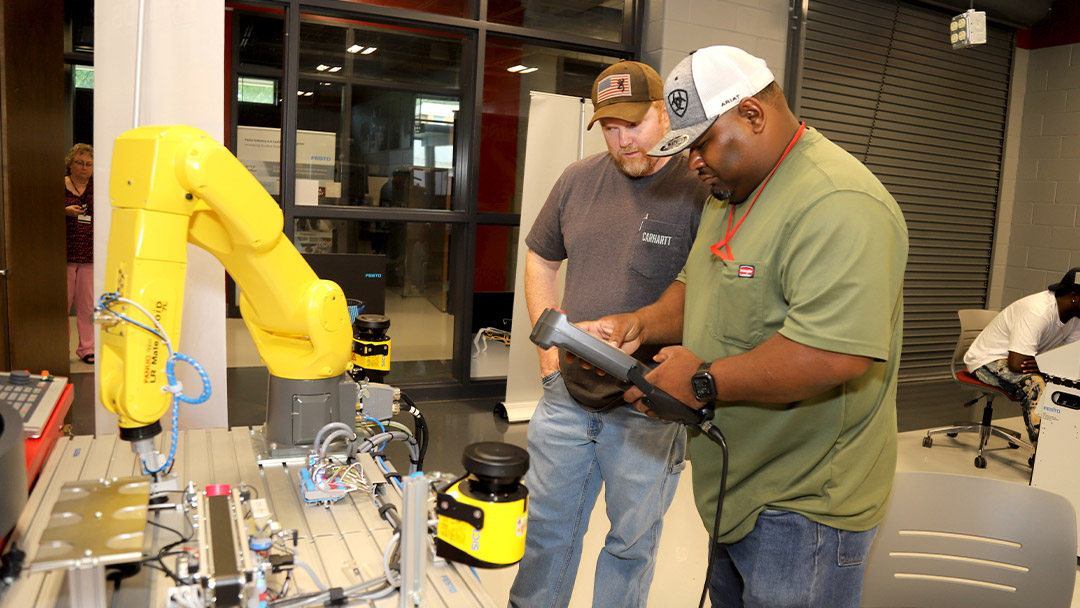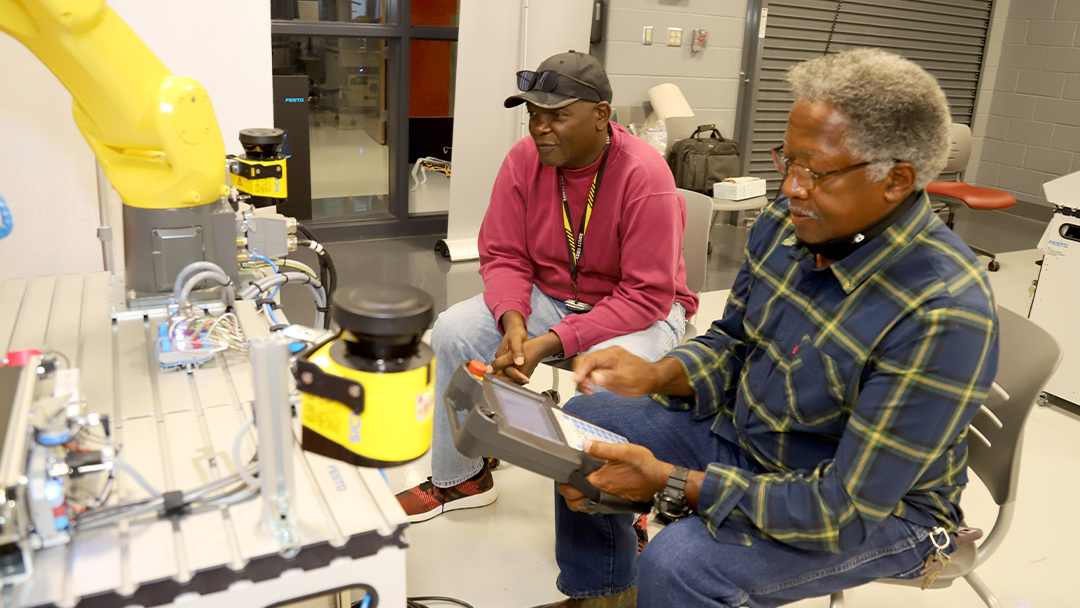Above: U.S. Army Corps of Engineer employees Johnny Henderson, left, and Lawrence Young practice their robotics skills in a two-week training session at Hinds Community College’s Vicksburg-Warren Campus.
Lawrence Young has been a crane operator “off and on” since 1975 but at age 67 he embraced a new challenge – robotics training for an upcoming upgrade at the U.S. Army Corps of Engineers where he works.
He and 14 other Corps employees spent two weeks in June at the George-Oakes Building at Hinds Community College’s Vicksburg-Warren Campus training to operate robotic equipment. Among other tasks, they used a keypad device that resembled a video game controller to operate a robotic arm that picked up and moved objects.
“I’m ready for the challenge. When you first start off on it, anything that is unknown is intimidating but as you get the feel of it your confidence level comes up. It’s going to be all right,” he said. “What’s a 67-year-old man doing in class? Learning.”
The students, a group of River Operations employees with the U.S. Army Corps of Engineers Vicksburg District, are part of the first robotics class designed to prepare them to work on ARMOR 1, a new automated vessel that will hit the water for the 2023 revetment season following the decommissioning of the 73-year-old Mat Sinking Unit.
The safety yellow robots in Hinds Vicksburg-Warren Campus classroom are stand-ins for ARMOR 1’s six enormous gantry cranes. Once in operation, the vessel’s cranes will operate simultaneously to move the concrete mat from the barge to the deck. According to Cross, the cranes will be able to lift two squares of the articulated concrete mat (ACM) at a time for a total weight of over four tons.
The class not only familiarized employees with the vessel’s robotics but also will sustain training on a semi-annual basis. To ensure maximum results, ARMOR 1 Senior Project Manager John Cross worked with the National Robotics Engineering Center (NREC) at Carnegie Mellon University in Pittsburgh, Pa., and Hinds Electro-Mechanical Instructor Jeff Hoovler for a tailor-made curriculum for district operators.

Chance Rebert, left, and Alvin Hammitte practice their robotic skills in preparation of changes at the U.S. Army Corps of Engineers in Vicksburg. Both were in training sessions at Hinds Community College’s Vicksburg-Warren Campus.
NREC previously developed the ARMOR 1 prototype at its Pittsburgh facilities, making it the organization’s largest robot ever produced.
Hoovler led the training supported by Casey Hutson, who works with Industrial Training Solutions who installed much of the Hinds equipment in the George-Oakes Building.
The Corps students were “learning how to write programs, how to make things work in succession and tie everything together to understand how automation and robotics work,” Hoovler said. “Most of these gentlemen haven’t been exposed to any of this.”
Cross said he worked with Hinds for two years to bring the course to fruition. “The new Hinds robotic and technical training center is first-rate and a great learning environment,” Cross said.
NREC previously developed the ARMOR 1 prototype at its Pittsburgh facilities, making it the organization’s largest robot ever produced.
Hinds Community College’s Associate Vice President for Workforce Development, David Creel, sees the class as an example of the strong partnership between Hinds and the district. “Our goal is to help people move forward in their careers,” Creel said. “The Corps is incredibly supportive of what we do here.”
Despite the novelty of the equipment, the trainees were enthusiastic about the training.
“I think it’s great. It’s a new way of life. It’s a chance to learn different things. Just about everything we’ve got is robotics. It’s a chance for us to learn something and get better and greater,” said revetment operator assistant manager Alvin Hammitte, who supervises approximately 300 crewmembers.
